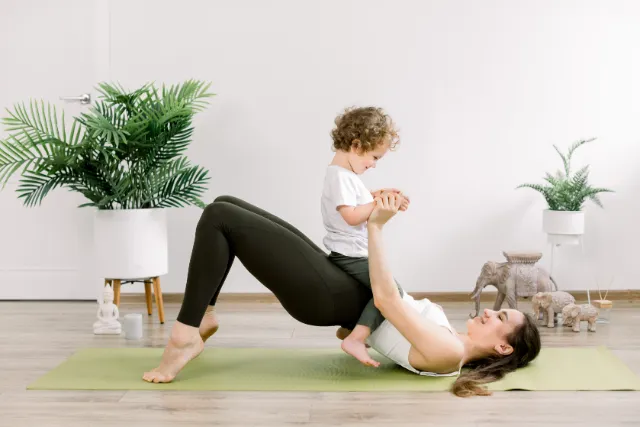Mum On The Run: Post-Natal Exercise Information

Your baby has arrived and the weeks disappear as you settle into life with your new addition. Slowly you emerge from the fog of those early days after birth and you start to crave a bit of normality back to your routine. For many women returning to exercise after your baby is high on the list of priorities. But how best to approach this? And how do you go from ‘post-natal’ exercises to ‘normal’ exercise again?
What is post-natal exercise and why is it an important consideration?
First of all, post-natal exercise is just exercise specifically targeted at the needs of the post-natal body. Years of slightly ambiguous information and generalisation have meant that health professionals are left with guidelines to work from that don’t necessarily match up to the clients’ hopes or goals. The information we work from is there to help protect the long-term health and function of your body. It hopes to stop you getting injured or develop long terms conditions like prolapse. It is always to the bewilderment of my friends and family working in Europe that here in the UK we don’t have physiotherapy follow up following birth as standard. It has been unfortunate to hear from clients that they are now subject to a ‘postcode lottery’ as to if they receive a 6-week postnatal review from their GP due to funding pressures. The long term impact of poor postnatal recovery can have a significant impact on the medical input required in later life. It is great to see a culture emerging of Mother’s being increasingly motivated to seek support in making an optimal recovery from their delivery. I am pleased to tell you that a new review of the evidence for the return to running after pregnancy has recently be issued. Let’s dive into what it has to say.
Running is understandably classed as a high impact exercise thus correlated with a higher rate of pelvic floor issues due to the loading delivered to the pelvis and lower body. The pelvic floor does not work in isolation and postnatal women are advised to do ‘core’ exercises to aid their recovery. ‘The Core’ is a cylinder comprising of the diaphragm and pelvic floor muscles and at the top and bottom of the cylinder, deep abdominal muscles (Tranversus Abdominus) wrap around the trunk and deep spinal muscles (Multifidus) like a zip up your back.
The tissues of the pelvic floor can be lengthened by pregnancy as well as delivery. A vaginal delivery can have significant impact on the tissue length and strength for at least 4-6 months. A C-section, on the other hand, whilst having a lighter influence on the pelvic floor, still requires up to 6-7 months for the scar tissue in the abdomen to recover its strength. Appreciating and allowing a fair time for the body to recover is the first step in a successful post-natal recovery. Try walking, swimming (when your scar sites have healed fully), post-natal yoga or Pilates focusing on nurturing your body and embracing the ability to bend down to your toes again!
How and when to start introducing loaded exercise?
So, after you have spent the first 3 months respectfully nurturing your body with supportive forms of exercise. The next step is moving on to loaded exercise like sports or impact. Before we rush ahead you should consider if YOUR body is ready yet. There are some signs that you should not ignore and ideally pursue as soon as you notice them. For instance, initially after labour your pelvic floor may feel very different and you may notice small leaks or a sensation of laxity in your pelvis or vagina. In the first weeks after delivery this is common and should resolve with pelvic floor exercises, avoiding heavy lifting and a healthy diet including excellent hydration to avoid constipation or straining. Symptoms to look out for and seek help for are:
- Continued bleeding beyond 8 weeks that isn’t your period.
- Bladder or Bowel leakage (including near misses or leakage of wind)
- Sensation of heaviness or bulging from the vagina.
- Pain with sex, physical activity or using a tampon/menstural cup in the vagina, pelvis or back.
- Doming at or pronounced tummy shape.
Any of the above should be followed up with an assessment by a health professional.
If you don’t have any of these distinct signs of pelvic floor issues you could use the following tests to see if you are physically ready to start increasing the loading of your workouts.
- Pelvic floor exercises: This is a strong indicator of the active support your body can provide for impact activities. Can you perform
- a) up to 12 reps of 8 second holds
- b) 10 short holds and 1-minute hold of a gentle squeeze? Can you do this in standing? Can you continue to breathe at the same time? Can you perform this against a strong forced out breath as if you were blowing out a candle?
- I use a test called ‘Rockers’ in which you try holding your pelvic floor squeeze in standing with side to side sway or forward rock going from one foot to the other. You are looking to see if your body can maintain its control as the weight moves through your pelvis just like walking . . . and eventually running.
- Another test could be that if you can comfortably complete a 30 minute walk with no symptoms, then you might like to test your balance to see if you can balance for more than 10 seconds on each leg. You could then progress this to single leg squat then a single leg hop. Lastly you could try jogging on the spot for at least 1 minute. You should be able to comfortably complete these with none of the above warning signs.
However, if the above tests are difficult you need to develop your lower body and pelvic stability. Pilates, Yoga and specific exercises used to test your body are a good place to start. You should aim to be able to challenge the muscles at the side back and front of the pelvis to ensure optimal control for when you add impact to your routine. Below are 4 exercises you can use to challenge these muscles. To get the most of them keep your back from arching or dipping your hips from side to side. If you find any of these particularly challenging, then this should be your focus before you try running or participate in impact sports alongside a Pilates programme.
Single Heel Raise:

Single Leg Sit To Stand:


Single Leg Hip Bridge:

Side Lying Lift & Lower:

Start with small positive changes
Generally speaking, though, it is important to always keep in mind that small positive changes in your activity levels can move you in the right direction to return to high impact sport. Protecting your body and making a comprehensive recovery is essential for long term participation in sport. So, eventually you’ll need to start training for what you’re trying to achieve. If your goal is running and you’re currently walking and doing your pelvic floor exercise in sitting during feeds then get proactive in making the changes your body needs like switching your exercises to standing or incorporating stability work.
When returning to impact exercise it is best to progress steadily and start at an achievable level, e.g. 3km per week, to allow the body time to adapt thus reducing the risk of injury. The ‘Couch to 5k’ programme has been popular for its progressive structured programme that guides you through the runs. Childcare can be a barrier to exercise and many women opt to start running with their baby in a buggy. Of course, ensuring your baby is in an appropriate buggy and not before the age of 6 months you need to remember that pushing a buggy can change the way you run. Generally, women complain of back or shoulder pain with this. Targeting your exercise programme to ensure good movement and strength at back, hips/pelvis will enable your body to move optimally in this style of running. A new sports bra and supportive clothing is highly recommended to ensure comfort.
Remember to maintain overall health and wellbeing
When it comes overall health and wellbeing, new mothers can find themselves susceptible to bugs and colds. This can be due to the new environments and excellent abilities of young children to share their germs, but also due to the increased pressure your body is under as you meet the demands of motherhood. Mothers find themselves trapped in a cycle of fatigue and reduced fitness with increased body weight. Prioritising a change in this cycle can help you escape the catch 22 of excessive loading on the pelvic floor from increased body weight, poor breathing patterns and digestive changes.
Emotional wellbeing also significantly impacts your motivation to undertake, as well as benefit from, physical activity. Accordingly, it’s necessary to strike the balance between your body and minds capacity for physical activity with its needs. On the flip side your body is already working hard for you and your baby. Asking more of your body might require for you to ‘upgrade’ your current habits. Simple things like ensuring adequate hydration, sleep and nutrition to fuel your body’s output.
Advice on overcoming Mum Tum
Understandably the stomach and trunk can have a different appearance after birth. As your baby grows, expanding your tummy, the muscles adapt around them. After delivery, the influence on the body’s strength and posture becomes more evident. You may have noticed a gap or doming of your tummy. This is likely to be due to the stretching of the connective tissue in the middle of the tummy. This softness results in a change in how your body controls movement. If you notice a distinct doming, back pain or bloating it is highly recommended that you see a physiotherapist to ensure you protect and rehab your core before you start high impact exercise. A specialist physiotherapist will help correct the changes, teach you the best exercise for your whole body and guide you through a return to sport.
Top tips for returning to exercise after giving birth:
We’e covered a great deal in this article. To draw everything together, these are our top tips for returning to exercise after giving birth:
- Allow your body the time it needs to heal.
- Keep to low impact exercise for at least 3months.
- Don’t progress to high loading if you are experiencing any symptoms of pelvic floor issues or joint pain.
- Gradually increase your exercise loading.
If you want to ensure your best post-natal rehab and would like to book with our Women’s Health team then please contact us on hello@katiebellphysio.com.

